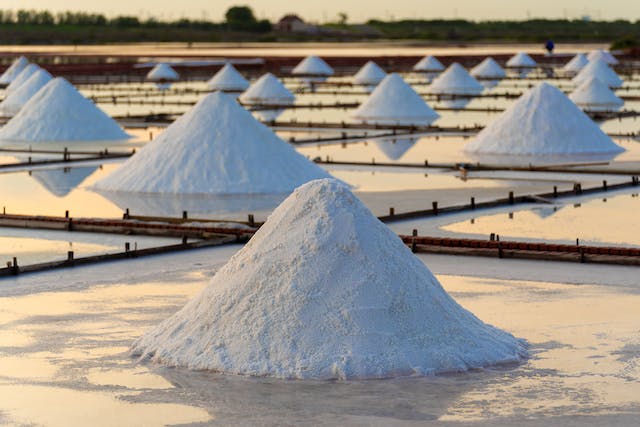
How is salt mined? In the same way that any other mineral is mined. There are three ways of producing salt. It can be mined out of the ground, it can be mined as a solution, or it can be left after the water is evaporated away.
Salt on Earth is usually found underneath the ground. Over the life of the planet, sea levels have been much higher than they are now and much lower than they are now. When sea levels are high, large parts of the land are submerged. As the sea levels fall, the land emerges from the sea and some of the submerged parts are cut off, forming large lakes of sea water. These lakes are not fed by the sea and, over time, they slowly evaporate leaving their salt behind. Then, through natural geological processes, the salt gets covered by other layers of sediment and is buried in the ground. Sea water is about 3.5% salt. Some seas, such as the Dead Sea, are far higher, but 3.5% is the average. This salt is dissolved in the water, which means it spreads out and is suspended in the water. However, the salt is not connected to the water, merely suspended by it. When the water evaporates, the water molecules pick up more energy from the sun and turn into a vapor, rising into the air. The suspended salt is not carried with them and is no longer suspended, so it is left behind.
Solution mining is the most common way that salt is mined and it is how most of the salt we use in our houses is produced. Solution mining is probably the easiest way to get the most salt out of the ground at the lowest cost. First, surveys have to be done to find the veins of salt in the ground. Once the salt has been found, several wells are dug around the salt deposit. The bottom of the wells are drilled sideways into the salt deposit. When the wells have been drilled, water is pumped down the wells and it enters the salt deposit, dissolving the salt. After enough time has passed, the brine is pumped out of the wells and taken to a processing plant. At the processing plant, the brine is pumped into sealed containers that boil the brine, evaporating the water and leaving the salt. The salt is removed from the containers, dried, refined, and then iodine and anti-clumping agents are added.
As an interesting aside – iodine has been added to most salt since about 1924. Iodine deficiency affects a lot of people around the world and in 1924, researchers realized they could put iodine in table salt and reach a large number of people. It only costs $1.15 to put iodine in 1 ton of table salt and it is slowly being taken up by many countries. The number of countries with iodine deficiency fell from 54 to 32 in the space of ten years.
The second method is salt mining. This is done in the same way that any mineral, such as coal, is mined. Two shafts are dug down to the salt deposit. One of the shafts is to lower people and the other is to lower equipment. Just like any mine, fresh air and ventilation is vital. The salt is mined in four steps. The first step is to cut a 3 meter deep section at the bottom of the salt to keep the floor level. The next step is to drill holes into the face of the salt and insert explosives. The third step is to ignite the explosives and blow the face of the salt wall off. Several thousand tons of salt can be blown off. The fourth step is to grind the salt and send it to the surface. The mining leaves large empty rooms, but to make sure the roof is supported, the miners leave pillars of salt every few meters. The ground salt is processed in a similar way to solution mined salt, except most mined salt is used in industry rather than for eating.
The third method is solar evaporation. This is the natural way salt flats form. A trapped inland sea evaporates faster than it can refill and salt is left on the ground. There are many natural salt flats around the world. This can also be done manually. Large ponds are filled with ocean water and left to evaporate. The resultant salt can be up to half a meter deep and it is collected with machines that are very similar to giant snow blowers.
Approximately 270 million tons of salt are produced worldwide every year and only 6% of that is used for human consumption. The rest is used in industries, such as making plastics and rubber. Chlorine and caustic soda are both made with salt and they are vital parts of many different industries. And this is what I learned today.
Photo by Timo Volz: https://www.pexels.com/photo/piles-of-salt-in-salinas-7855174/
Sources
https://www.saltean.com/salt-production/
https://science.howstuffworks.com/innovation/edible-innovations/salt4.htm
https://www.canr.msu.edu/news/what_is_the_difference_between_table_salt_and_sea_salt
https://www.wieliczka-saltmine.com/individual-tourist/about-the-mine/geology-of-the-mine
https://www.usgs.gov/faqs/why-ocean-salty
https://en.wikipedia.org/wiki/Salt_mining
https://www.mcgill.ca/oss/article/food-health-you-asked/why-iodine-added-salt
https://globalhealthnow.org/object/iodized-salt
https://eusalt.com/about-salt/salt-uses/industry/
